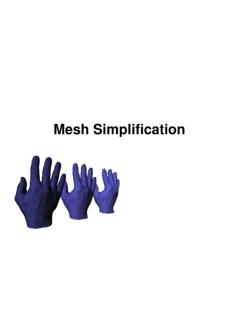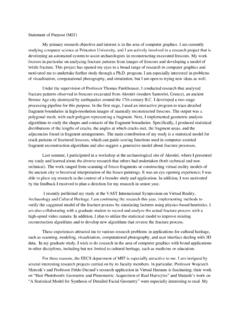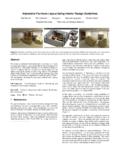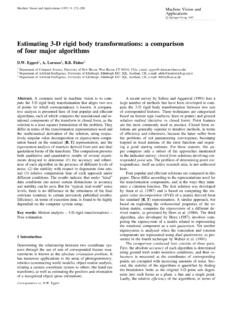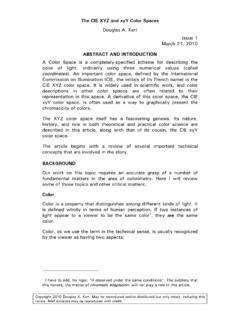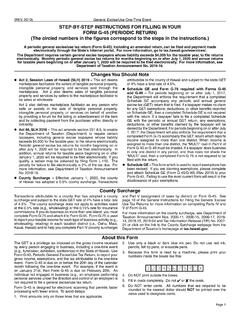Transcription of Designing Effective Step-By-Step Assembly Instructions
1 Designing Effective Step-By-Step Assembly InstructionsManeesh Agrawala Microsoft ResearchDoantam PhanStanford UniversityJulie HeiserStanford UniversityJohn HaymakerStanford UniversityJeff KlingnerStanford UniversityPat HanrahanStanford UniversityBarbara TverskyStanford UniversityAbstractWe present design principles for creating Effective Assembly in-structions and a system that is based on these principles. The prin-ciples are drawn from cognitive psychology research which investi-gated people s conceptual models of Assembly and Effective meth-ods to visually communicate Assembly information. Our system isinspired by earlier work in robotics on Assembly planning and in vi-sualization on automated presentation design. Although other sys-tems have considered presentation and planning independently, webelieve it is necessary to address the two problems simultaneouslyin order to create Effective Assembly Instructions .
2 We describe thealgorithmic techniques used to produce Assembly Instructions givenobject geometry, orientation, and optional grouping and orderingconstraints on the object s parts. Our results demonstrate that itis possible to produce aesthetically pleasing and easy to follow in-structions for many everyday :Visualization, Assembly Instructions1 IntroductionMany everyday products, such as furniture, appliances, and toys,require Assembly at home. Included with each product is a set ofinstructions showing how to put it together [Mijksenaar and West-endorp 1999]. For modular product lines, such as customizable of-fice furniture, many different versions of the Instructions are neces-sary. As the number of customizable products and demand for task-specific Instructions increase, technology will be needed to produceinstructions more cost effectively.
3 Already there is a high incidenceof poorly designed and out of date problem is that it is difficult and expensive to design as-sembly Instructions that are easy to understand and follow. Sincethe instruction design process has not been systematized, skilledhuman designers are needed to produce good Instructions . As a re-sult, the process of producing Instructions is time-consuming andlabor-intensive. Computer support is currently limited to replac-ing low-level tools such as pen and paper. Most high-level designdecisions are still made by human have developed a system that provides higher-level tools fordesigning Assembly Instructions . Figure 1 depicts Instructions pro-duced with our system. A broader goal of our work is to understandhow humans produce and use visual Instructions .
4 By codifying thisdesign knowledge in computer programs, we can make it easier to 1: Assembly Instructions for a TV stand. Our system plans the set of assemblyoperations to show in each diagram and then renders action diagrams which explicitlydepict the operations required to attach each clear drawings of 3D objects and more Effective instruc-tions [Tversky et al. Submitted].The two primary tasks in Designing Assembly Instructions are: Planning:Most objects can be assembled in a variety ofways. The challenge is to choose a sequence of Assembly op-erations that will be easy for users to understand and follow. Presentation:There are many ways to depict Assembly op-erations. The challenge is to convey the Assembly operationsclearly in a series of tasks have been independently studied in the areas ofrobotics and visualization.
5 Assembly planning is a classic problemin robotics [Wolter 1989; de Mello and Sanderson 1991; Wilson1992; Romney et al. 1995]. Given the geometry of each part in theassembly, an Assembly planner computes all geometrically feasiblesequences of Assembly operations. These plans are used by roboticmachine tools for automated manufacturing and are not meant to beseen, understood, or carried out by humans. Most robotic assemblyplans would seem unnatural to people assembling everyday contrast, automated presentation design systems have been de-veloped in the domain of visualization [Feiner 1985; Mackinlay1986], with the goal of producing diagrams that are easy for hu-mans to understand. These systems assume that the information tobe portrayed is given as input and automatically design an effectivediagram to convey that information.
6 Although some of these au-tomated presentation systems have been developed to illustrate 3 Dobjects and actions [Seligmann and Feiner 1991; Rist et al. 1994;Butz 1997; Strothotte 1998], their primary focus has been on show-ing the locations or physical properties of approach is inspired by a combination of ideas from theseprevious systems. However, we believe that decisions involved inplanning and presentation are strongly intertwined. Therefore bothissues must be considered contributions of our work include:Cognitive design principles for Effective Assembly Instructions :We performed cognitive psychology experiments to identify howpeople conceive of the Assembly process and to characterize theproperties of well-designed Instructions . Based on the results ofthese experiments and prior cognitive psychology research, weidentify design principles for Effective Assembly Instructions .
7 Theseprinciples connect people s conceptual model of the Assembly taskto the visual representation of that system instantiating these design principles:Our assemblyinstruction design system consists of two parts: a planner and apresenter. The planner searches the space of feasible Assembly se-quences to find one that best matches the cognitive design princi-ples. To do this the planner must also consider many aspects ofpresentation. The presenter then renders a diagram for each step ofthe Assembly sequence generated by the planner. The presenter alsouses the design principles to determine where to place parts, guide-lines and arrows. In particular, the presenter can generate actiondiagrams which use the conventions of exploded views to clearlydepict the parts and operation required in each Assembly Design Principles for Assembly InstructionsBefore we can develop automated tools for Designing Assembly in-structions, we must understand how people think about and com-municate the process of assembling an object.
8 Cognitive psycholo-gists have developed a variety of techniques to investigate how peo-ple mentally represent ideas and concepts. We recently performedhuman subject experiments based on these techniques to determinethe mental representations underlying Assembly [Heiser and Tver-sky 2002]. We briefly describe our experimental the first experiment, we asked participants to assemble a TVstand, given only a photograph of the completed stand as a they assembled the TV stand, we asked them to create a setof Instructions that would show another person how to assemble of the diagrams they drew are shown in Figure 2. In thesecond experiment, we asked a new group of participants to rankthe effectiveness of a subset of the Instructions produced in thefirst experiment.
9 Finally, the third experiment tested whether thehighly ranked Instructions were more Effective . Yet another groupof participants used Instructions ranked in the second experiment toassemble the TV stand, while experimenters recorded task comple-tion time and error rates. We found that in general the highly ratedinstructions were easier to understand and follow. Participants spentless time assembling the TV stand and made fewer on these experiments, as well as earlier cognitive research,we identify a set of design principles for creating Assembly instruc-tions that are easy to understand and and grouping of parts:People think of assemblies asa hierarchy of parts. At the base level, parts are segmented by per-ceptual salience indexed by contour discontinuity; that is, parts thatare disjoint are more likely to be segmented.
10 Typically, the dis-joint parts are also grouped by different functions ( the legs ofa chair or the drawers of a desk) [Tversky and Hemenway 1984].When possible, people prefer that parts within a group are addedto the Assembly at the same time, or in sequence one after part groups are usually considered as hierarchical structures,which parallel the subassembly structure of the DiagramAction DiagramFigure 2: Hand-drawn Assembly diagrams for the TV stand. The action diagram ispreferable to the structural diagram because it depicts the operations required to attacheach part. In this case the action diagram shows how the shelf is fastened by the of operations:People think of the attachment opera-tions required to build an Assembly as a hierarchy of actions on theparts [Zacks et al.]

